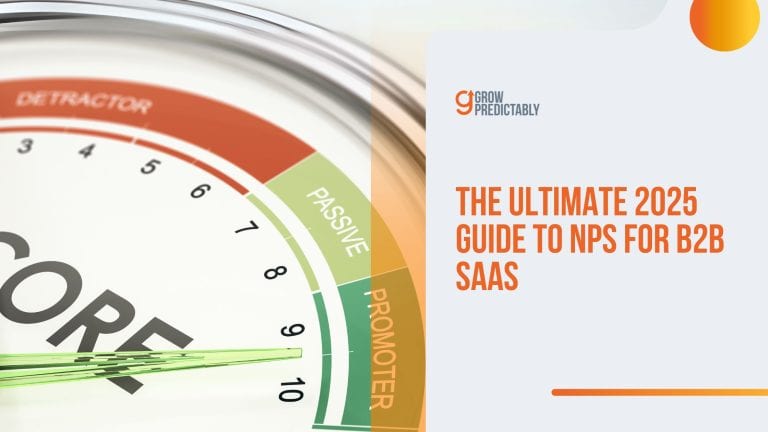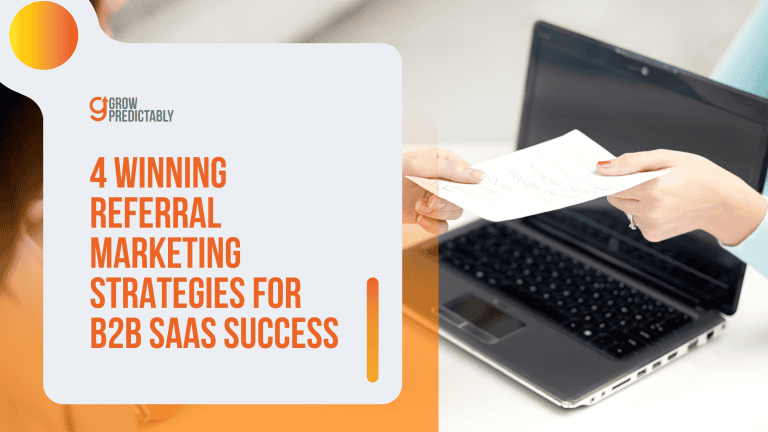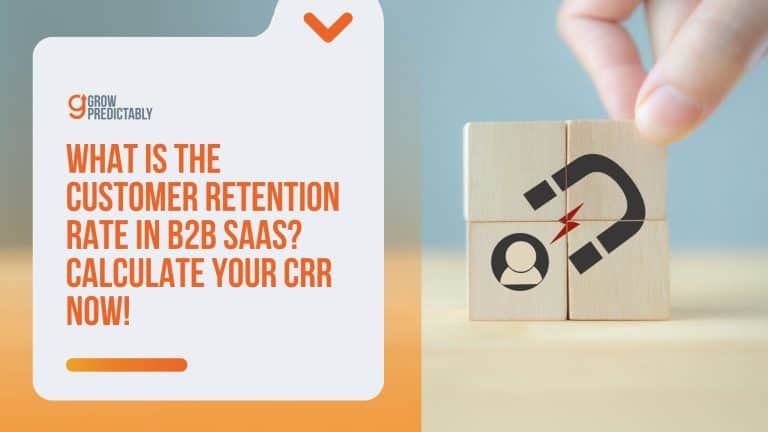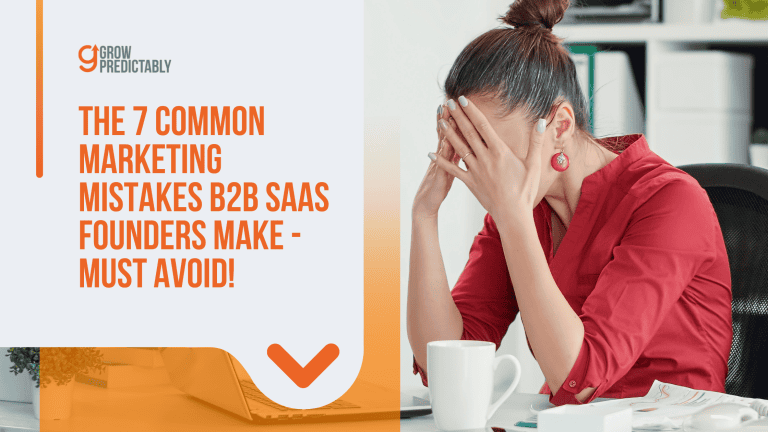Top 10 B2B SaaS Marketing Book Every Founder Should Read
What separates struggling B2B SaaS startups from the ones that scale?
It’s not funding.
It’s not features.
It’s understanding how to market a SaaS product the right way.
If you’re guessing your way through marketing, you’re wasting time and money.
But you don’t have to.
The lessons you need are already out there, written by experts who’ve done it.
These 10 books, considered among the best B2B SaaS marketing books, will teach you the exact strategies to grow and dominate.
Which book will change your business?
Let’s dive in!
1. “Traction” by Gino Wickman

Maintaining operational efficiency can feel like an uphill battle in the often chaotic world of SaaS businesses, where rapid growth and constant innovation are the norms.
Gino Wickman’s “Traction” introduces the Entrepreneurial Operating System (EOS), perfect for SaaS leaders aiming to streamline operations and focus on growth without getting bogged down in day-to-day disruptions.
With EOS, Wickman emphasizes clarity and alignment across six key business components, which resonate deeply with anyone tasked with scaling a tech organization.
His strategies to enhance vision and accountability are especially useful for SaaS founders looking to unite their teams around a common goal.
Key Benefits:
- Align team dynamics and processes
- Enhance strategic clarity and accountability
- Institutionalize scalable and efficient processes
Additionally, the book provides essential insights into developing a robust go-to-market strategy, which is critical for positioning products effectively and navigating market challenges.
What makes “Traction” invaluable for the SaaS space is its focus on process documentation, ensuring that growth is scalable and efficient.
This book is a go-to resource for turning fast-moving startups into well-oiled machines.
2. “Hooked” by Nir Eyal
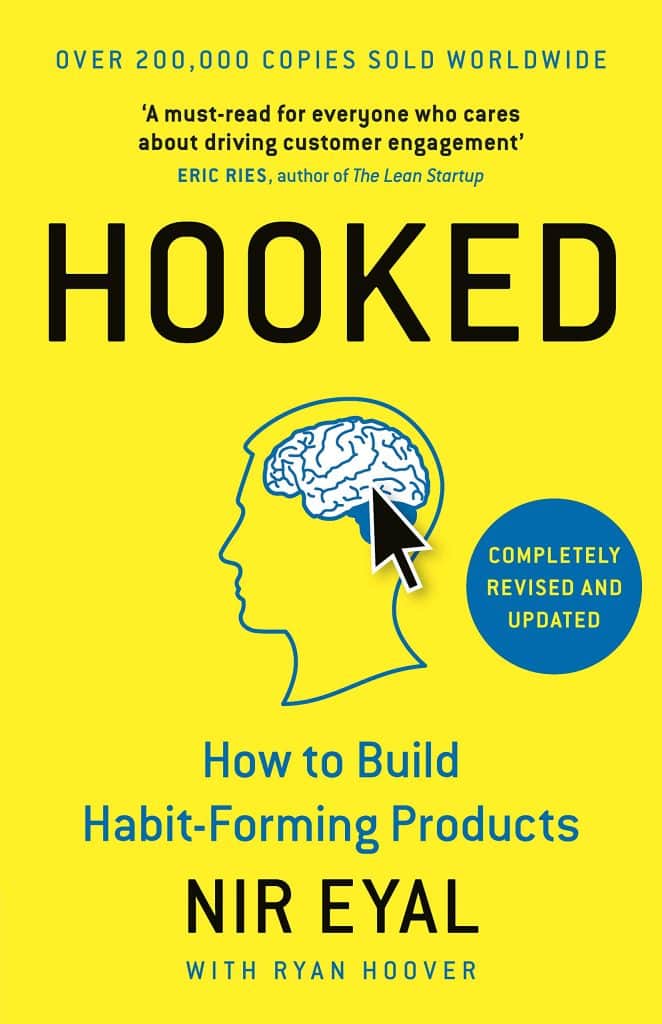
In the competitive SaaS landscape, the ability to design a product that becomes an indispensable part of users’ routines can set your offering apart from the crowd.
Nir Eyal’s “Hooked” is a treasure trove of insights into habit-forming product design, blending behavioral psychology with practical design advice.
Eyal details how to effectively use trigger mechanisms to engage users, which is key for SaaS products aiming for a sticky user experience.
Core Concepts:
- Design effective user triggers
- Implement variable rewards to maintain engagement
- Foster user investment to deepen product reliance
The exploration of variable rewards provides a blueprint for enhancing user retention, a crucial component for achieving a low churn rate, which is often a key performance indicator in SaaS.
Developing effective product-led strategies and positioning can help retain customers by creating engaging product experiences that foster loyalty and sustainable growth.
The focus on user investment is particularly compelling for SaaS, as it encourages building features that lead users to invest their time and data, increasing product indispensability.
3. “Inbound Marketing” by Brian Halligan and Dharmesh Shah

For SaaS companies flooded by the cacophony of digital advertising, standing out requires more than just big budgets—it demands strategic content that naturally draws users in.
“Inbound Marketing” by Brian Halligan and Dharmesh Shah is a playbook for SaaS marketers looking to shift from outbound messages to inbound magnetism.
The book provides invaluable guidance on generating content that resonates with educated SaaS buyers, emphasizing methods to attract qualified leads through genuinely helpful and relevant information.
Essential Takeaways:
- Craft content that converts SaaS leads organically
- Implement data-driven SEO for maximum reach
- Use social media to deepen user engagement
It highlights how effective content marketing can transform a struggling business by focusing on authenticity, transparency, and addressing customer needs, thus establishing authority and driving growth.
The SEO strategies discussed are highly relevant, ensuring your content finds its way to the right SaaS decision-makers.
Halligan and Shah also delve into how social media can be leveraged to extend reach and enhance customer engagement without the inefficient spend associated with ads.
4. “Play Bigger” by Al Ramadan, Dave Peterson, Christopher Lochhead, and Kevin Maney

We know that incremental improvements aren’t enough in the SaaS industry; true success comes from redefining the market itself.
“Play Bigger” introduces the innovative concept of category design, offering a strategic framework for establishing a unique market position that elevates your product to a league of its own.
The authors guide you in crafting a category strategy that positions your product as the definitive solution in a newly created space.
Game Changing Insights:
- Develop a category strategy to dominate new market spaces
- Craft narratives that position your product as the category leader
- Sustain market leadership through ongoing innovation
They explain how to control the narrative around your market, ensuring your innovation sets the standard and shapes customer expectations.
They also delve into the critical phase of transitioning from early adopters to the mainstream market, emphasizing strategic marketing and the challenges faced during this transition.
This book is more than a guide—it’s a manifesto for becoming not just a market participant, but a category king through continual adaptation and innovation.
5. “Product-Led Growth” by Wes Bush

Why depend solely on traditional sales tactics when your SaaS product can be its most influential advocate?
Wes Bush’s “Product-Led Growth” redefines this approach by positioning the product itself at the center of your growth strategy.
This concept is particularly relevant in the SaaS industry, where user experience and onboarding can significantly impact customer satisfaction and retention.
Key Elements:
- Enhance onboarding processes to showcase value rapidly
- Innovate based on user insights for sustained product improvement
- Develop growth loops for efficient scaling
Bush emphasizes designing a seamless onboarding process to demonstrate value quickly, focusing on continuous user-driven innovation to refine the product.
Creating a minimum viable product (MVP) is crucial in this process, as it allows for iterative learning and feedback-driven adjustments, which are essential for significant revenue growth, especially in B2B software companies.
The goal is to create growth loops—self-sustaining user acquisition processes that fuel expansion without the typical costs associated with sales-led models.
6. “From Impossible to Inevitable” by Aaron Ross and Jason Lemkin

The path can seem daunting for SaaS businesses aspiring to scale from $1 million to $100 million in revenue.
Aaron Ross and Jason Lemkin’s “From Impossible to Inevitable” delivers a comprehensive roadmap to make this journey possible and predictable.
Known for pioneering ‘predictable revenue’ strategies, Ross and Lemkin reveal the key elements for achieving substantial growth in the SaaS market.
Scalable Strategies:
- Implement repeatable revenue recipes tailored for SaaS models
- Optimize market expansion tactics for broader reach
- Structure teams for efficiency and rapid scaling
The book outlines specific revenue recipes designed to align with your SaaS business model, explores market expansion techniques and marketing strategies that help you reach new audiences, and provides insights into structuring a sales team ready for hyper-growth.
Their combined expertise guides you through transforming ambitious goals into clear, actionable steps.
7. “Obviously Awesome” by April Dunford

Articulating the distinctive value of your product is crucial.
April Dunford’s “Obviously Awesome” is a definitive guide to mastering market positioning, ensuring that your product’s unique strengths are not only recognized but revered by your target audience.
Dunford’s positioning framework is both insightful and practical, helping you pinpoint the differentiators that matter most to your audience as part of a comprehensive marketing strategy.
Actionable Insights:
- Utilize a positioning framework to identify key differentiators
- Ensure messaging clarity to communicate benefits effectively
- Differentiate in a crowded market with unique value propositions
She emphasizes the importance of messaging clarity, a critical factor for reaching potential customers with a compelling narrative that resonates.
By focusing on competitive differentiation, Dunford equips you with the tools to highlight what truly sets your product apart, making you not just another option, but the obvious choice.
8. “Customer Success” by Nick Mehta, Dan Steinman, and Lincoln Murphy

In SaaS, where recurring revenue models are the norm, churn is a silent but potent threat to profitability.
“Customer Success” by Nick Mehta, Dan Steinman, and Lincoln Murphy provides an indispensable toolkit for transforming customer satisfaction into customer success, ultimately leading to sustained growth and profitability.
The authors delve into developing robust customer retention models that prioritize proactive engagement and support.
Strategic Pillars:
- Implement proactive customer retention models
- Track success metrics to improve customer engagement
- Cultivate advocates to amplify positive business impacts
By focusing on key success metrics, they guide you in monitoring and enhancing customer relationships, ensuring every user achieves their desired outcomes with your product.
They also emphasize the importance of a structured sales process, leveraging data and technology to optimize and make it more effective.
Furthermore, their strategies for cultivating customer advocates add another layer of value.
By turning satisfied customers into vocal champions, your product’s reputation can soar through authentic word-of-mouth marketing.
9. “The SaaS Sales Method” by Jacco Van Der Kooij

Traditional sales tactics often fall short in the evolving B2B SaaS market.
Jacco Van Der Kooij’s “The SaaS Sales Method” brings a refreshingly modern perspective on selling in today’s dynamic environment, focusing on alignment with how buyers make decisions rather than outdated pressure tactics.
Van Der Kooij emphasizes buyer-centric selling, urging sales teams to adapt their approach according to the buyer’s journey.
Innovative Strategies:
- Embrace buyer-centric selling to align with decision-making processes
- Practice value-based persistence in sales engagements
- Apply SaaS-specific sales techniques for effective results
His method of value-based persistence ensures that sales engagements are persistent yet respectful, demonstrating genuine understanding and continual value to the prospect.
Insights from Ben Horowitz, a co-founder of a venture capital firm, further highlight the importance of practical advice for navigating business challenges and decision-making in startup leadership.
The book also explores SaaS-specific sales techniques tailored to the nuances of software-as-a-service products, ensuring that sales efforts are transactional and transformative, leading to long-lasting partnerships.
10. “Behind the Cloud” by Marc Benioff

For those seeking inspiration from a luminary who has truly reshaped the SaaS landscape, “Behind the Cloud” is indispensable.
Marc Benioff, the visionary founder of Salesforce, shares his extraordinary journey from a fledgling startup to an industry titan.
This book is not only a testament to Benioff’s entrepreneurial spirit but also a practical guide for those aspiring to carve their niche in the SaaS sector.
Key Takeaways:
- Extract invaluable lessons from Benioff’s comprehensive experiences
- Foster a culture of innovation that empowers your team
- Master strategic agility to pivot and thrive in changing markets
Benioff provides candid insights into the entrepreneurial lessons he garnered along the way, openly discussing both triumphs and setbacks.
His emphasis on cultural innovation is particularly poignant for SaaS leaders looking to cultivate a dynamic workplace where creativity and forward-thinking are inherent values.
The narrative also explores strategic agility, showcasing how Salesforce adeptly navigated market shifts and challenges.
By learning from these experiences, you can better position your own SaaS venture to be both resilient and adaptable.
Key Takeaways:
- Extract invaluable lessons from Benioff’s comprehensive experiences
- Foster a culture of innovation that empowers your team
- Master strategic agility to pivot and thrive in changing markets
Why Every B2B SaaS Founder Needs to Read These Books
You’re at the helm of a B2B SaaS company, which means you’re navigating an industry that’s equal parts thrilling and competitive.
Whether you’re striving to disrupt markets or seeking sustainable growth, equipping yourself with the right knowledge can make all the difference.
That’s where reading the right books comes in.
Gaining New Perspectives
Books offer insights that are often drawn from years of experience, trial, and error.
They provide new ways of thinking about old problems, exposing you to ideas you might not encounter in your day-to-day operations.
Learning from the successes and failures of industry leaders through these narratives can help you avoid common pitfalls and seize opportunities you might have overlooked.
Building a Strategic Framework
Having a clear strategy is crucial in the SaaS world.
Books can teach you how to position your product in the market effectively, ensuring that you’re not just another player, but a leader.
They offer strategic frameworks that help you focus your efforts, prioritize initiatives, and allocate resources more efficiently.
Enhancing Customer Understanding and Engagement
Your customers are at the heart of everything you do.
Many books delve into understanding customer behavior and how to build stronger, more lasting relationships with them.
From creating a product that becomes indispensable to finding innovative ways to reduce churn, the knowledge you gain can directly impact your customer success strategy.
Scaling Operations and Teams
Rapid growth can be both exciting and overwhelming.
Reading about operational tactics and leadership strategies will prepare you for scaling challenges, from organizing your team effectively to maintaining company culture as you grow.
Books can provide you with actionable advice on growing your business sustainably and strategically.
Improving Sales and Marketing Approaches
In today’s marketplace, traditional tactics might not always cut it.
Books can offer innovative approaches to sales and marketing that align with the modern buyer’s journey, helping you connect with customers in more meaningful and effective ways.
This can lead to more genuine engagements and ultimately, stronger sales performance.
By immersing yourself in these books, you not only gain practical knowledge but also the inspiration to push boundaries and innovate within your business.
They are more than just a collection of theories—they’re a reservoir of wisdom that can guide you toward achieving your business goals in the ever-evolving SaaS landscape.
Picking up these reads could be one of the most strategic decisions you make on your entrepreneurial journey.
How to Apply B2B SaaS Marketing Book Insights to Your SaaS Business
Reading insightful books can truly change the game for your SaaS business, but the real power comes from putting those ideas into action.
Let’s explore how you can translate these lessons into strategies that drive growth and innovation.
The goal is to take those aha moments and integrate them into your daily operations to see real, tangible results.
Here are some personal tips to help you on this journey.
1. Build an Actionable Plan
Start by capturing the key insights from each book that resonate with your business’s unique challenges and aspirations. This is about turning inspiration into a clear path forward.
- Highlight What Matters: Identify the nuggets of wisdom that directly address your current challenges.
- Prioritize Your Moves: Focus on implementing the most impactful ideas first, to avoid feeling overwhelmed.
- Set Clear Goals: Define what success looks like for each initiative, making it easy to measure progress and celebrate wins.
Keep a dedicated notebook or digital document for book takeaways. After finishing a book, review your notes and create a shortlist of three actionable ideas you can start on immediately.
Having a prioritized action plan will create a strategic roadmap that drives progress and keeps your initiatives on track.
2. Adapt Strategic Frameworks
Books often present strategies that have been tested and proven.
Think about how you can adapt these frameworks to your specific business environment.
It’s about making these strategies feel natural and intuitive within your own operations.
- Apply Best Practices: Integrate successful strategies into your current frameworks to enhance efficiency and effectiveness.
- Collaborative Brainstorming: Involve your team in discussions about how to customize these ideas, leveraging their insights and expertise.
Host a “Strategy Day” where your team can discuss and experiment with new frameworks from the books. Offering incentives, like lunch or team-building activities, can enhance participation and creativity.
3. Encourage a Learning Culture
Creating a culture of continuous learning and improvement can be a huge asset.
Sharing insights from these books with your team can ignite fresh ideas and foster collaboration.
Together, you can build a dynamic and adaptable organization.
- Host Book Clubs: Encourage your team to read and discuss these books, allowing for shared learning and diverse insights.
- Create a Knowledge Base: Document insights and strategies, making them accessible to your team for future reference.
Rotate the role of ‘discussion leader’ in book club meetings. This not only spreads responsibility but also engages team members actively in the learning process.
4. Enhance Your Customer Focus
Focus on integrating customer-centric strategies gained from these readings to improve service and satisfaction.
You can foster loyalty and drive growth by understanding and meeting customer needs more effectively.
- Revamp Customer Success: Use new insights to create proactive customer success plans that improve engagement and satisfaction.
- Personal Touch: Implement personalized strategies for key clients to ensure they see value and success with your product.
Create a customer advisory board composed of your most engaged users. Use insights from these groups to refine your understanding and application of customer-centric strategies.
5. Refresh Sales and Marketing Techniques
Books can inspire fresh ways to connect with your audience.
Updating your sales and marketing approaches with new insights ensures your strategies are both modern and practical.
- Test New Ideas: Employ new techniques like inbound marketing or product-led growth to engage your audience.
- Feedback and Tweak: Continually refine these methods based on feedback and results, ensuring they’re optimized for success.
Allocate a small “innovation budget” for testing new marketing ideas inspired by your reading. Monitor the results closely and scale successful strategies across your campaigns.
Putting the insights from these books into practice is more than just a smart move; it’s essential to growing and scaling a successful SaaS business.
By being proactive and strategic in applying these lessons, you’ll not only solve immediate challenges but also position your company for the long term.
This approach to continuous learning and application—enhanced by these personal tips—will set your business up for sustained growth and innovation.
FAQs
Your SaaS Breakthrough Awaits
We’ve just uncovered some of the most powerful marketing books that have transformed struggling founders into thriving SaaS leaders.
Each offers a unique lens on scaling your business—from consistent customer acquisition to building an unshakable brand presence.
But here’s the real difference-maker: Execution.
You have the strategies now; will you take action?
I challenge you to pick just one book from this list, dedicate 30 minutes a day to reading it, and implement a single key insight in your marketing efforts.
That one decision could change everything.
Want to go even further?
Check out additional resources like the SaaS Growth Stacking Podcast or join a mastermind group where founders discuss real-world growth strategies.
The path to success is more straightforward when taken with like-minded peers.
Before you go, ask yourself: If you don’t level up your marketing today, how much potential growth will you leave on the table this year?
The best SaaS founders know that learning never stops.
Will you commit to this mindset shift?



